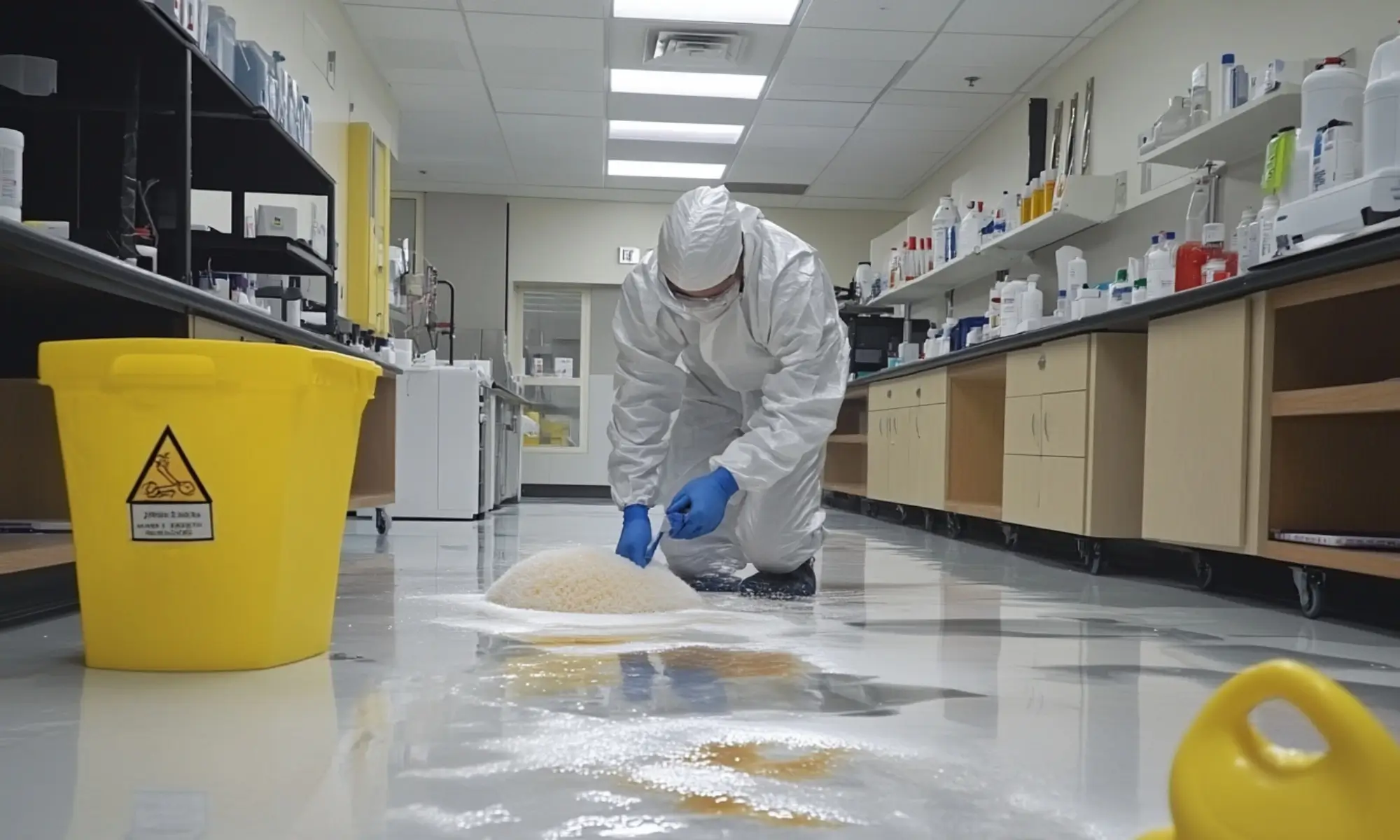Maintaining safety is paramount in workplaces where hazardous chemicals are present. The Safety Data Sheet (SDS), formerly known as the Material Safety Data Sheet (MSDS), is a vital document that provides comprehensive information about a chemical, enabling safe handling, storage, and emergency response.
This guide thoroughly explores the 16 sections of an SDS, providing essential insights and practical advice for professionals, safety officers, and workers.
Understanding the Role of SDS
Safety Data Sheets are standardized documents mandated by regulations such as OSHA’s Hazard Communication Standard (29 CFR 1910.1200). Adhering to the Globally Harmonized System (GHS) guidelines, SDSs help communicate chemical substances’ properties, hazards, and safe handling practices. These documents are essential for safeguarding health and safety and ensuring compliance with safety regulations.

16 Sections of the Safety Data Sheet (SDS)
The 16 sections of the Safety Data Sheet (SDS) are a standardized set of categories used to communicate essential information about hazardous chemicals. These sections include identification, hazard identification, composition, first aid, firefighting measures, accidental release measures, handling and storage, exposure controls and personal protection, physical and chemical properties, stability and reactivity, toxicological information, ecological information, disposal considerations, transport information, regulatory information, and other information.
Each section serves a specific purpose: to inform users about safe handling practices, potential risks, and emergency procedures, as well as to ensure worker safety and compliance with health and safety regulations. Let’s discuss each section of the Safety Data Sheet (SDS).
1. Identification
Section 1 of the SDS is designed to provide essential details for identifying the chemical product and understanding its recommended uses. It also includes vital contact information for the manufacturer or supplier so users know who to contact for additional information or in emergencies.
Key Elements Explained:
- Product Identifier (Name and Synonyms): This is the unique name of the chemical, which may include its commercial or technical name, trade name, or synonyms. The product identifier ensures that users can accurately identify the chemical in use.
- Manufacturer/Distributor Contact Information (Address, Phone Number, Emergency Contact): This part lists the manufacturer or supplier’s name, complete address, phone number, and an emergency contact number that users can call in case of an incident. This contact information is crucial for obtaining more information about the chemical or seeking help during an emergency.
- Recommended Uses and Restrictions: This field outlines how the chemical should be used (e.g., in industrial processes, as a cleaning agent) and any limitations or prohibited uses (e.g., “Not for consumer use”). This helps ensure that the product is used safely and appropriately.
Why It Matters: This section lets users quickly identify the chemical they are handling and ensures they know how to use it correctly. It provides a point of contact for emergencies, enabling prompt action to prevent or address chemical exposure incidents.
2. Hazard Identification
This section communicates the potential hazards posed by the chemical and provides a summary of critical safety information. It ensures that users know the risks associated with handling the substance.
Key Elements Explained:
- Hazard Classification (e.g., Flammable, Corrosive): This categorizes the chemical based on its physical, health, and environmental hazards. Examples include classifications such as “Highly Flammable Liquid” or “Skin Corrosive.”
- Signal Word (e.g., “Danger” or “Warning”): A signal word is used to indicate the severity of the hazard. “Danger” denotes a more serious hazard than “Warning.”
- Hazard Statements (e.g., “Causes Skin Irritation”): These statements describe the nature and degree of the hazard posed by the chemical. Each hazard class and category has specific hazard statements conveying potential risks.
- Pictograms Representing Specific Hazards: Pictograms are standardized images that symbolize the type of hazard, such as fire for flammables or an exclamation mark for irritants.
- Precautionary Statements and Descriptions of Unclassified Hazards: These provide information on preventing or minimizing adverse effects through safe handling practices.
Why It Matters: This section plays a vital role in risk assessment, helping users understand the dangers of a chemical at a glance and take appropriate precautions. Clear hazard identification promotes safer work practices and reduces the risk of accidents.
3. Composition/Information on Ingredients
Section 3 lists the product’s chemical composition, providing information on each hazardous ingredient. This allows users to understand what is present in the mixture and its potential effects on health and safety.
Key Elements Explained:
- Chemical Name, CAS Number, and Concentration: The Chemical Abstracts Service (CAS) number is a unique numerical identifier that helps users precisely identify chemical substances. This section also indicates the concentration or percentage of each hazardous ingredient.
- Information on Impurities or Stabilizing Additives: If the chemical contains impurities or additives that affect its overall classification, they must be listed here.
Why It Matters: Knowing the composition is crucial for understanding the nature of potential exposure risks. It helps users decide on the necessary personal protective equipment (PPE) and control measures needed to handle the chemical safely. This information is also vital for medical personnel in case of exposure, as it helps determine appropriate treatment.

4. First Aid Measures
Section 4 provides detailed instructions on the initial care that should be given to an individual who has been exposed to the chemical. This is not meant to replace professional medical treatment but to offer immediate measures to mitigate harm before medical help arrives.
Key Elements Explained:
- General First Aid Steps for Inhalation, Ingestion, Skin, and Eye Contact: This outlines the specific actions to take for different types of exposure, such as moving the individual to fresh air for inhalation exposure or rinsing the eyes with water for eye contact.
- Immediate Symptoms and Delayed Effects: Details the symptoms that may appear immediately and those that could be delayed. This helps users understand what to watch for after exposure.
- Recommendations for Medical Attention: Indicates whether immediate medical care is required or if special treatment, such as the administration of specific antidotes, is needed.
Why It Matters: This section is critical for workplace safety. Quick and effective first aid can greatly reduce the severity of an exposure incident and ensure that affected individuals receive the right type of medical care. This readily available information can make the difference between a minor and a major incident.
5. Firefighting Measures
Section 5 provides guidance on how to deal with fires involving the chemical, ensuring that emergency responders and workers can take appropriate action to extinguish the fire safely.
Key Elements Explained:
- Suitable and Unsuitable Extinguishing Methods: This section identifies the types of fire suppression agents (e.g., water, foam, dry powder) that should be used or avoided. For example, water might be inappropriate for certain flammable liquids as it could spread the fire.
- Specific Hazards Arising from Combustion: This section lists the dangerous by-products that might be released when the chemical burns, such as toxic fumes or gases.
- Special Protective Equipment for Firefighters: This refers to the type of protective gear (e.g., respirators, chemical-resistant suits) that firefighters should wear to protect themselves while dealing with a fire involving chemicals.
Why It Matters: Understanding how a chemical reacts during a fire can prevent further hazards and protect those fighting it. This section helps ensure that appropriate firefighting equipment is on hand and that responders can approach the situation with the right protective measures.
6. Accidental Release Measures
Section 6 of the SDS outlines the necessary steps to take for an unintentional spill, leak, or chemical release. This section ensures that organizations have a proper response plan to prevent further hazards and limit exposure to individuals and the environment.
Key Elements Explained:
- Emergency Protocols: These include initial actions that should be taken immediately following a spill, such as evacuation procedures, cordoning off the affected area, and notifying relevant authorities or safety personnel.
- Recommended PPE and Containment Methods: This section details the personal protective equipment (PPE) needed to handle a spill safely and the techniques for containing the spill (e.g., dikes, absorbent materials).
- Clean-Up Strategies: Instructions for safely cleaning up the chemical, whether using specific cleaning agents, absorbents, or specialized tools. This may also include instructions for safely disposing of collected waste.
Why It Matters: Proper handling of accidental releases minimizes environmental damage, limits health risks, and reduces the potential for escalating the situation into a more severe hazard. Ensuring the right response can protect workers and mitigate long-term consequences on the environment.

7. Handling and Storage
This section provides comprehensive guidelines for safely handling and storing the chemical to prevent accidents, reduce exposure risks, and maintain the chemical’s integrity over time.
Key Elements Explained:
- Handling Precautions to Prevent Exposure or Reactions: This section outlines how to handle the chemical safely, including any specific practices such as using ventilation, avoiding open flames, or wearing protective equipment to minimize exposure.
- Safe Storage Requirements, Including Temperature and Ventilation: Provides details about where and how to store the chemical, such as ideal temperature ranges, humidity levels, and the need for proper ventilation to avoid dangerous accumulations of vapours or fumes.
- Incompatibilities: List substances or conditions that should be avoided to prevent dangerous reactions, such as acids, bases, oxidizers, or direct sunlight.
Why It Matters: Adhering to proper handling and storage guidelines prevents chemical accidents such as spills, fires, or harmful reactions. It also helps ensure that the chemical remains effective and safe for use over its intended shelf life.
8. Exposure Controls/Personal Protection
Section 8 focuses on the preventive measures and controls needed to minimize exposure to the chemical, ensuring that workers are protected while handling it.
Key Elements Explained:
- Permissible Exposure Limits (PELs) and Threshold Limit Values (TLVs): Indicates the maximum amount of chemical exposure considered safe for workers. These limits, often set by regulatory agencies such as OSHA or the ACGIH, inform users of the acceptable levels of exposure.
- Recommended Engineering Controls: Describes environmental controls, such as exhaust ventilation or fume hoods, that help reduce the presence of hazardous substances in the air.
- Specific PPE, such as Gloves, Masks, or Goggles: This specifies the personal protective equipment required for handling the chemical safely, such as chemical-resistant gloves, safety goggles, respirators, or protective clothing.
Why It Matters: Understanding exposure controls and the correct PPE ensures that workers can handle chemicals safely, minimizing the risk of health issues related to exposure. This section is crucial for maintaining a safe work environment and complying with occupational safety standards.
9. Physical and Chemical Properties
Section 9 provides detailed information on the chemical’s properties, which helps users understand how it behaves under various conditions. This knowledge aids in assessing potential risks and ensuring safe handling.
Key Elements Explained:
- Physical State, Color, and Odor: This section provides details on what the chemical looks like and any noticeable odor, which can help in identifying the substance.
- pH, Melting/Freezing Points, and Boiling Points indicate how the chemical reacts to temperature changes and whether it may freeze, boil, or break down under standard conditions.
- Solubility, Vapor Pressure, and Flammability: Lists how the chemical dissolves in water or other substances, the pressure at which it turns to vapour, and whether it is flammable.
Why It Matters: These properties help assess risks associated with using and storing the chemical, such as understanding if it is prone to ignition or how it behaves when exposed to water or other substances.

10. Stability and Reactivity
This section provides information about the chemical’s stability and the potential reactions it might undergo, helping users understand how to prevent dangerous situations.
Key Elements Explained:
- Conditions to Avoid (e.g., Heat, Moisture): This section specifies environmental factors that can destabilize the chemical or trigger reactions, such as excessive heat or exposure to moisture.
- Incompatible Materials: Lists other substances that should not be mixed with the chemical to prevent hazardous reactions, such as strong acids or bases.
- Hazardous Decomposition Products: This category identifies dangerous by-products that might be produced when a chemical breaks down due to exposure to heat, air, or other substances.
Why It Matters: Knowing the stability and reactivity of a chemical is crucial for safe storage and handling. Identifying conditions that could lead to reactions or decomposition helps prevent incidents such as fires, explosions, or releasing toxic gases, ensuring workplace safety.
11. Toxicological Information
Section 11 details the potential health effects of the chemical when exposure occurs, offering a thorough understanding of the associated risks. This section helps in assessing the dangers posed by acute or chronic exposure and guides necessary safety measures.
Key Elements Explained:
- Routes of Exposure (e.g., Inhalation, Ingestion): Lists the possible ways the chemical can enter the body, such as through breathing (inhalation), swallowing (ingestion), or skin contact.
- Symptoms and Health Impacts (Acute and Chronic): This category describes immediate and long-term health effects, such as irritation, dizziness, or organ damage. Acute effects refer to short-term exposure, while chronic effects stem from repeated or prolonged exposure.
- Toxicity Data (e.g., LD50): Provides quantitative measures of toxicity, such as the lethal dose required to kill 50% of a test population (LD50). This data helps quantify the chemical’s potential danger and severity of exposure outcomes.
Why It Matters: This section is vital for recognizing signs of exposure and ensuring that workers and medical personnel can act promptly to mitigate health impacts. Understanding the toxicological properties also aids in proper training for safe handling and emergency responses.
12. Ecological Information (Non-Mandatory)
Section 12 provides data on the chemical’s potential environmental effects. It assesses how the chemical behaves in the ecosystem and its long-term impact on living organisms and the environment.
Key Elements Explained:
- Bioaccumulation Potential: Indicates whether the chemical can accumulate in living organisms over time, which could affect the food chain.
- Environmental Toxicity: Describes the toxic effects on wildlife, such as fish, plants, and other organisms, to understand the severity of environmental exposure.
- Degradation and Persistence in Water or Soil: Details how long the chemical remains in the environment and whether it breaks down naturally or persists, posing long-term risks.
Why It Matters: Understanding ecological information helps develop better safety protocols for accidental spills and determine appropriate environmental safeguards. This section is essential for ensuring compliance with environmental protection regulations and minimizing ecological harm.

13. Disposal Considerations (Non-Mandatory)
Section 13 offers guidance on how to safely dispose of the chemical and any containers or materials contaminated by it. Proper disposal ensures the chemical does not pose additional hazards after use.
Key Elements Explained:
- Proper Disposal Methods: This section recommends ways to dispose of the chemical in accordance with safety and environmental regulations, such as incineration or special treatment facilities.
- Special Precautions and Prohibited Disposal Routes: This section highlights precautions to take during disposal and warns against improper methods, like pouring the chemical down the drain or disposing of it with regular waste.
Why It Matters: Proper disposal practices help prevent environmental contamination and protect public health. This section also assists organizations in adhering to waste disposal laws and regulations.
14. Transport Information (Non-Mandatory)
Section 14 provides necessary details for the safe transportation of the chemical, ensuring that it is shipped according to national and international regulations to minimize transport risks.
Key Elements Explained:
- UN Number and Proper Shipping Name: This section lists the unique identification number for hazardous materials and the proper name used during shipping.
- Transport Hazard Class: Indicates the category of hazard (e.g., flammable, toxic) assigned to the chemical during transport.
- Packaging and Special Precautions: This section details how the chemical should be packed to prevent leaks or reactions and any precautions for handling during transit.
Why It Matters: This section ensures that chemicals are transported safely and comply with regulations. Adhering to these guidelines helps prevent accidents during shipment and protects handlers, transporters, and the environment.
15. Regulatory Information (Non-Mandatory)
Section 15 includes any safety, health, or environmental regulations specific to the chemical that are not mentioned in other parts of the SDS. This can help users stay informed about additional compliance requirements.
Key Elements Explained:
- Relevant Local and International Regulations: Lists specific rules or guidelines that apply to the handling, storage, or disposal of the chemical, which may vary by country or region.
- Other Safety Documentation: This section references any additional documents or regulatory data that may assist with compliance or provide further safety information.
Why It Matters: This section ensures that organizations are aware of all legal obligations related to the chemical. It helps companies comply with local and international laws, reducing the risk of regulatory violations and associated penalties.
16. Other Information
The final section of the SDS includes the original preparation date and a summary of any revisions made. It may also contain additional safety information that wasn’t included in other sections.
Key Elements Explained:
- Original Preparation Date: Indicates when the SDS was first created, providing a reference for how current the safety data is.
- Revision History: Lists updates or changes made to the document, ensuring that users know if they have the most recent version.
- Additional Relevant Information: This may include information such as the source of the data, abbreviations, or references to more in-depth resources.
Why It Matters: Keeping this information up to date is essential for ensuring that workers have access to the latest safety data. This helps maintain accurate safety protocols and effective risk management within the workplace.
Conclusion
Understanding the 16 sections of a Safety Data Sheet equips workers, safety managers, and emergency responders with the knowledge to handle hazardous chemicals safely and effectively. Familiarity with these sections ensures preparedness, compliance with safety regulations, and protection against workplace incidents. Always ensure your SDS documents are up-to-date and accessible to those who need them.

